The Vishera Review: AMD FX-8350, FX-8320, FX-6300 and FX-4300 Tested
by Anand Lal Shimpi on October 23, 2012 12:00 AM ESTProjected Performance: Can AMD Catch up with Intel?
I keep going back to this slide because it's incredibly relevant. It's the only indication we have from AMD of what its future roadmap will look like in terms of performance increases:
Each year AMD promised to increase performance of its high-end cores by roughly 10 - 15%. Astute observers will note that, at this rate, AMD will almost never catch up to Intel. AMD at the time was careful to point out that it's talking about 10 - 15% gains in core performance, and it could potentially see even larger increases in total chip performance by pulling other levers. Vishera is an example of AMD doing just that. The Piledriver cores by themselves don't increase performance tremendously, but they do give AMD a little more thermal headroom to work with thanks to some more efficient design decisions and better transistor choice. With Vishera, AMD took the additional power headroom and turned into a frequency advantage. The result is AMD's FX-8350 can operate in the same power envelope as the outgoing FX-8150, yet runs at an 11% higher base clock (turbo frequency remains the same). Through frequency and core level improvements, AMD was able to deliver a bit more than the 10 - 15% performance increased in promised.
If AMD is able to repeat these improvements again next year, I wondered whether or not it would get any closer to closing the gap with Intel - particularly when it came to single threaded performance. We already know from our Haswell investigations that Intel is expecting around a 5 - 15% increase in CPU performance from Haswell over Ivy Bridge. If we assume that Haswell delivers towards the 15% end of that spectrum, and if we assume that Steamroller delivers the same level of improvements that we saw from Piledriver/Vishera, we end up with some pretty interesting predictions for where things end up next year. I modeled the 2013 performance of high-end AMD and Intel platforms based on those two factors and plotted the curves in a few different benchmarks. For each generation I used the parts that AMD stacked up against one another (they are also fairly similarly priced). For 2011 I used the FX-8150 vs. Intel's Core i5 2500 and for 2012 I used the FX-8350 vs. Intel's Core i5 3570. The 2013 data is of course projected based on a 15% increase in performance from Haswell, and a repeat of the Vishera vs. Zambezi increase for AMD. This is mostly an interesting experiment so don't get too invested in the data.
We'll start with Cinebench, by far the most painful of the tests for AMD from a single-threaded performance perspective:
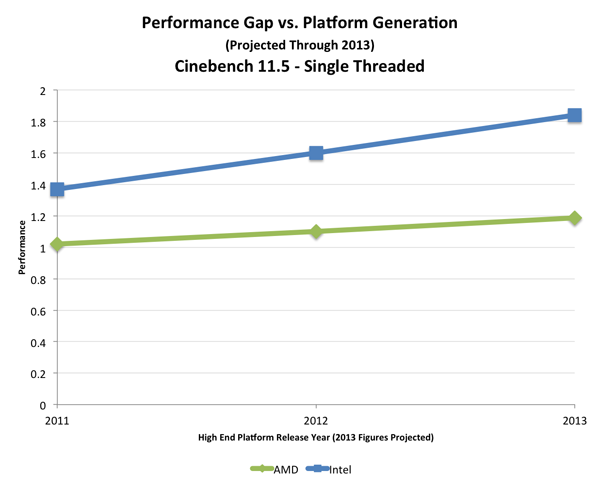
The Vishera gains here were decent but not enough to dramatically shrink the performance gap. Furthermore, Intel put a good amount of distance in place with Ivy Bridge and if it can continue that with Haswell I don't see much hope here.
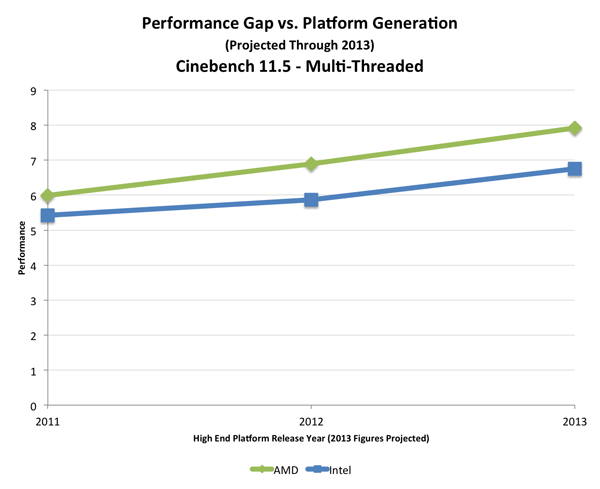
The multithreaded Cinebench results begin in AMD's favor and remain so even with our projected performance data.
Mozilla's Kraken benchmark is another example of single threaded performance gone awry for AMD.
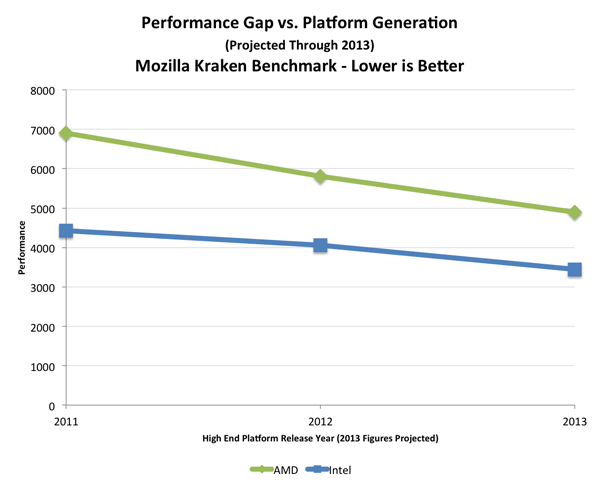
Thankfully, Vishera does close the gap by a decent amount and if AMD extends those gains it is on an intercept course with Intel. The bad news is, that intercept wouldn't be in 2013.
POV-Ray provides another point of view on single threaded performance, here the situation looks far less dire than under Cinebench:
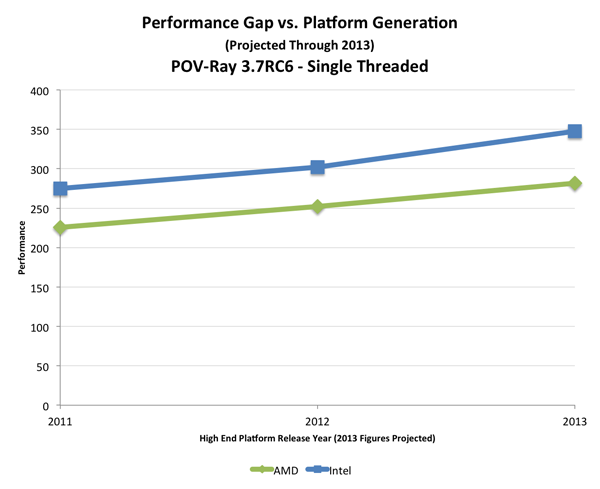
Unfortunately the curves remain fairly distinct.
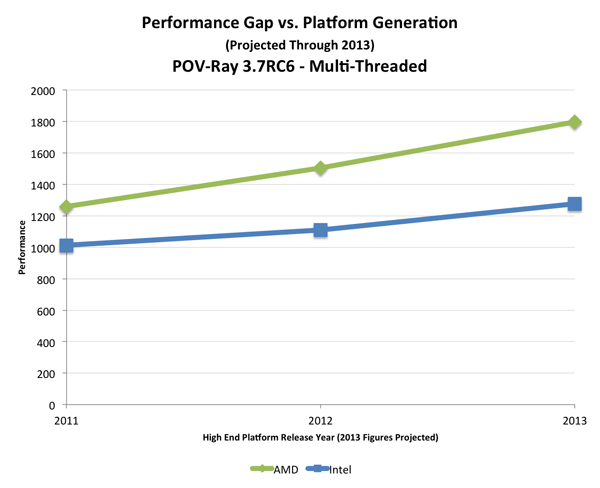
Once again, when we increase thread count we see AMD pull ahead.
SYSMark is a particularly telling benchmark as it is lightly threaded and does a good job of simulating all types of workloads:
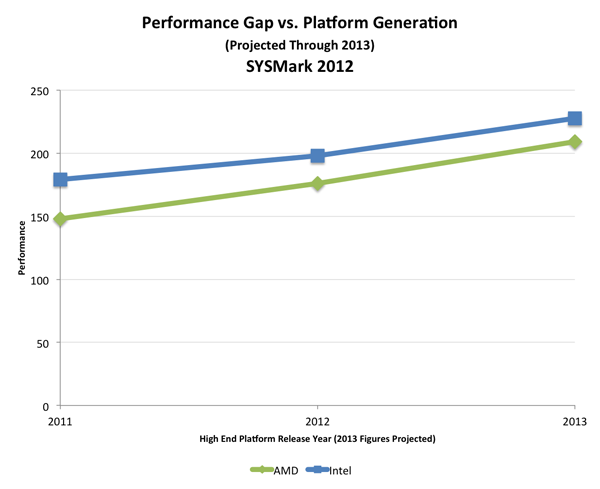
The result here is AMD closing in, albeit slowly, on Intel's performance advantage. I suspect this is quite possibly the best case scenario for AMD, it doesn't necessarily want to surpass Intel in performance but it wants to get close enough where pricing and other factors (e.g. GPU performance in its APU parts) can make a bigger difference.
Our Visual Studio 2012 test is a good combination of single threaded and multithreaded workloads in one:
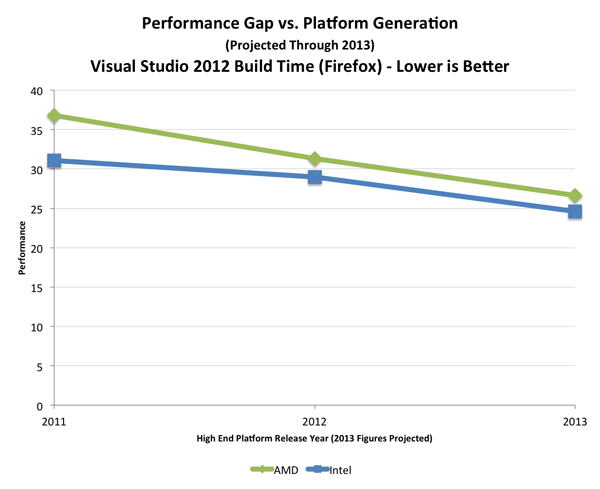
With Vishera, AMD did a lot to close the gap betwen itself and Intel. Another increase like this and we won't see AMD surpass Intel, but the two should remain fairly close.
These last two tests show us the other side of the coin. If both AMD and Intel continue on their present tracks, what will happen in a test where AMD already does well today?
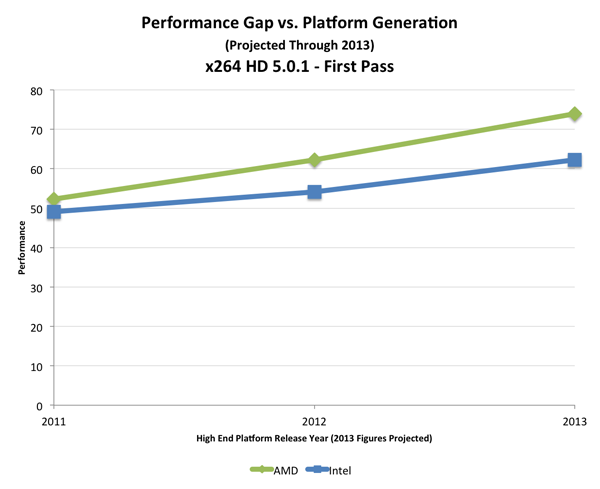
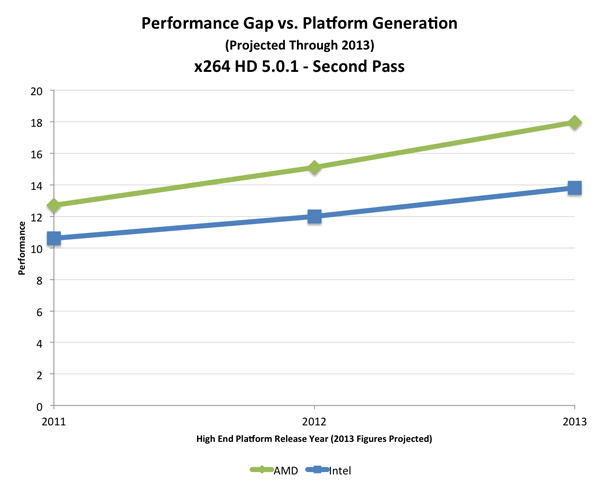
In areas where AMD holds a significant advantage, Haswell would need to deliver more than a 15% gain in performance at the same price point to catch up.
None of the results here are all that surprising. AMD remaining on its current course isn't enough to dramatically change its standings vs. Intel in another year. Vishera definitely cut into the performance delta, but the 2013 follow-up will have to do even more to really have an impact. Steamroller is far more focused on increasing IPC, however without a new process node it'll be difficult to demonstrate another gain in frequency like we see today with Vishera. I suspect the real chance for AMD to approach parity in many of these workloads will be with its 20nm architecture, perhaps based on Excavator in 2014.











250 Comments
View All Comments
pmartin - Thursday, January 3, 2013 - link
Please shut the hell up.captg - Wednesday, October 24, 2012 - link
What about someone with an AMD Phenom II X4 940 Black Edition at stock speeds?Wisenos - Wednesday, October 24, 2012 - link
i run my 965 @ 4ghz... 1.48v 20x200mhzOrigin64 - Wednesday, October 24, 2012 - link
4.8GHz? My Phenom II doesnt even do 4, but I have an extremely shitty mobo. vdrops like a downer after a suger rush.BSMonitor - Tuesday, October 23, 2012 - link
Except that it requires nearly double the power of a Ivy Bridge to squeak out a few wins in those multi-threaded apps... Only when a company is this close to obscurity can we say this is a win. Especially in light of ARM competition with x86... AMD continues with insanely power hungry chips?? Not good.At $200 it still is a tough sell. Double the power of i5-3570K and 80W more than i7-3770K. No way. The chip looks dated. cough cough Pentium 4 Prescott anyone?
What market is AMD aiming at here?!? Intel produces 2 IVB per 1 of these. And IVB is an APU of all things.. This thing is AMD's non-iGPU part. Imagine if Intel released an 6-8 core IVB without the iGPU. Same die size as the IVB APU.
Bleak does not even begin to describe AMD. The fact that AMD sits at $1.5B market cap and no one is talking about buying the company says a lot.
CeriseCogburn - Tuesday, October 30, 2012 - link
Thank you for the proficient monitoring, although I disagree with at least the characterization of calling it a win based upon amd being on it's way out, or whatever.It gets called and referred to as a win, because honesty is now CRAP, and fanboy fruittard is "in". That's all.
When there is some bare win for amd in some game, then of course it's a massive killing and total destruction, and sometimes when it's a tie or a lose it gets called and manipulated and talking pointed and spun into a win.
Personally, I believe that's why amd is a freaking failure. They coddled and produced a large raging fanboy base, with their PR hits against nVidia and Intel, all of it lies that the fruiters totally believed, and went on a continuous rampage with.
That emotional battery allowed AMD to produce crap, not support their crap properly, feel good about their little warm and "not evil" hearts they pretended to "live by", and thus go down the frikkin tubes while bathing themselves in glory.
The very few times the massive collective of lockstep fanboy parrots broke out of their idiot mind chains and actually criticized AMD, and it only occurred several times mind you, after much ignoring and glossing over, why then AMD, shocked and stunned - WOKE THE HECK UP... got off their coddled PR fanboy based BUTTS - and did something about their huge problem...
I must say the results those few times were extraordinary for AMD, and quite exemplary in any overall comparison across the board to other companies in the mix. A few examples of that should not be hard to bring to mind.
That's why I don't like the fanboy crap. I certainly don't believe it's good for amd, nor good for my bottom line, as I suffer under the constant coddling and lying, too.
We all do.
Now it's likely too late, but I'm still hoping for a bailout for amd. Lots of oil sheiks out there.
Yoda's apprentice - Wednesday, June 26, 2013 - link
It kind of bothers me how you ignore that you're exactly the same fanboy too.Wolfpup - Tuesday, October 23, 2012 - link
Yeah! I'm really impressed how much better these are...the fact that they're beating Intel again in ANYTHING is awesome!We need AMD for the competition, and anymore with Intel pushing their worthless video so hard, it gives AMD a competitive advantage both because they can skip video and have more transistors on CPU, OR they can put in a massively better GPU.
I wish they had an 8 core notebook part though for the mid range with no integrated GPU....it seems like that ought to be a solid enough choice for a system, combined with a high end Nvidia or AMD GPU.
Seriously thinking of making my next notebook AMD, both to support them, and to avoid switchable graphics... (well, still have AMD's switchable graphics, but hopefully since they make the whole thing they'll do better).
I used to be scared off by AMD as I got burnt twice on horrible 3rd party chipsets, but I bought a c50 based notebook last year for the kitchen, and it's been 100% rock solid stable and non-weird...like Intel's always been known for. Makes me feel a lot better about buying an A series notebook this year or an FX desktop.
Beenthere - Tuesday, October 23, 2012 - link
FYI - Anandtech is suffering server issues at the time of this post...What many reviewers and fanbois tend to miss over and over is that AMD is delivering the best performance-for-the dollar and that ANY current model desktop CPU will run ANY software just fine. Unless you have some enterprise level software that brings a modern CPU to it's knees, ANY of the currently avialable desktop CPUs will run Windoze or Linux based software just fine. In fact Linux apps do even better in many cases than Windoze bloatware.
I have no idea if AMD will ever offer a discrete CPU to equal Intel's top of the line, over-priced models nor do I care. I buy what delivers the best performance for the price. I have yet to purchase any AMD desktop CPU that would not run ALL software as well as an Intel CPU, without any isses what so ever.
If all you do is benchmark all day long and you have money to burn, blow it on an Intel CPU, unless of course you are opposed to evil, chronic, law violating corporations looking to eliminate consumer choice. You could always vote your conscience, if you have one.
I am always amazed that people actually falsely believe that AMD processors are some how "inadequate". Even with tainted benches, AMD processors deliver all the performance and good value that most consumers desire. It's tough however getting people to look at the data objectively. All most people think of is that "more" is better, when in fact that's the sucker play when you look at performance vs. cost and actual needs.
Considering that Intel got a whopping ~5% performance gain from a 32nm to 22nm node drop and Tri-gate tansistors with Ivy Bridge, (along with over-heating and poor overclocability...), AMD did quite well to deliver a ~10-15% improvement with Vishera. With AMD's pricing Vishera should sell well because of it's excellent performance and cost.
zappb - Tuesday, October 23, 2012 - link
Hear Hear!Good to see AMD back in the saddle again, and with stellar performance in multi threaded stuff...